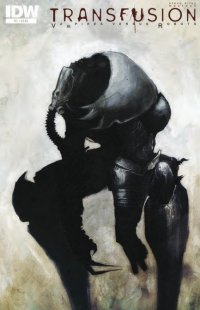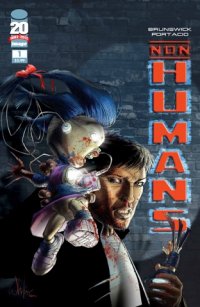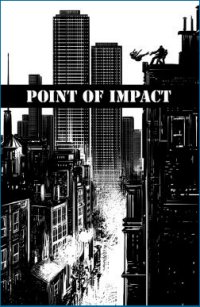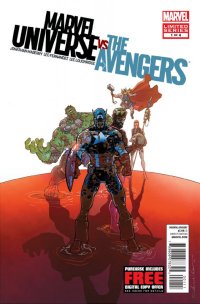Uncanny Avengers #1 (Marvel, $3.99)
By Jeb D.
I’m not much good at list-making: my favorites in areas like movies, music, books, etc., are always shifting, depending on mood, context, and new exposure. And my list of favorite comic artists can twist and turn as well: some artists are better than others at finding projects and/or collaborators that they’re well suited for, so I can go from following an artist compulsively to skipping their work altogether, if the material’s not right. Given all that, then, for me, John Cassaday’s batting average is pretty high: Planetary, I Am Legion: The Dancing Faun, and Astonishing X-Men are all among my very favorite comics of the past decade or so (his brief run on Captain America was pretty sweet, as well), and given the chance to revisit Marvel’s spandex roster, he takes full advantage here: his version of Thor is formidable, Cap’a a convincing leader, X-characters that didn’t figure heavily in his Astonishing run (including Havok and Rogue) are sharply defined, Wolverine is perfectly realized, and Cassaday is that rare artist who can give us a visual Wanda Maximoff with the perception and intelligence needed to wield her chaos powers, while never downplaying the sex appeal at the heart of the character’s popularity (there’s a facial closeup during her encounter with Rogue that is so expressive as to be haunting). In addition, Cassaday and writer Rick Remender have come up with a truly fascinating super-team (from another dimension?) to pit against these two female powerhouses; they are not the typical analogs of the Avengers, X-Men or Justice League: their powers, and character design, are the sort of fresh air that the original Inhumans (or Morrison’s Doom Patrol) provided in their day.
Of all the recent indie stars to write for Marvel, Remeder is the one with the most outrageously comic-booky imagination, and he bookends this comic with a truly disturbing bit of supervillainy: as with Marvel Universe vs The Avengers (see my review below), this issue ends with a last-page character reveal, but trust me: even if you’ve seen the advance cover of issue #2, tipping you off as to who the baddie is, you’re definitely not prepared for the twisted scheme that Remender has provided him, or for the gleefully horrifying way that Cassaday depicts it. Remender’s handle on the other characters is solid (he thankfully imports a bit of Thor’s characterization from the Ultimate/movie versions), and he gives Cassaday a nice range of both intimacy and spectacle in this first issue. And I haven’t even touched on the team’s depiction of Cyclops, which gets under your skin in ways this character almost never has before.
Ranking a book like this is always tough: no corporate-managed superhero comic can ever fully exploit the medium’s possibilities in the way that, say, a Chris Ware or Charles Burns, can. But in the context of the beginning of whatever Marvel Now! conceives itself to be, and as a way of hooking readers on its future potential, it’s hard to imagine it being done any better.
Rating: 




Out of a Possible 5 Stars
 ONCE UPON A TIME MACHINE TPB (Dark Horse, $24.99)
ONCE UPON A TIME MACHINE TPB (Dark Horse, $24.99)
By Devon Sanders @devonsanders
When I first started writing this, it began as a review but then, it became something… else.
It became more testimonial. You see, Once Upon A Time Machine, an anthology of classic fairy tales reimagined and re-spun throughout various genres, was edited and conceived by someone I literally watched grow up. I watched them grow up loving comics.
Indulge me, please; Andrew Carl, the co-editor and one of the many writers within this anthology, is a friend of mine. As a teen, he’d come into the comics shop I managed and you could see the genuine love this guy had for comics, even at an early age. The only thing was that, sometimes, he had no idea where to go with it. So, occasionally, you’d see a copy of Spawn in his hand. Time, trial and error and my smacking his hand, turned Andrew into one of my comics shops’ most astute customers and eventually, I even hired him for the summer. In that time, he became a friend and someone whose opinion I’d wholeheartedly listen to.
Eventually, he went off to college and I’d figured that would be the last I’d hear of him. No. He’d still stop in and pick up comics and still want to talk about things. One of the things he’d talk about is a desire to someday make the comics he’d both like to see on comics shelves.
This week, I will very proudly be selling Once Upon A Time Machine in my comics shop. I say “very proudly” not because he’s a friend but as someone who absolutely loves a good story. The hard work put behind “Once” is a good story but the stories themselves, tells everything one needs to know. This is a gorgeous, GORGEOUS presentation. Clocking in at over 400 pages, this book is the type of thing I absolutlely adore; beautifully crafted genre stories that take full advantage of the medium of comics.
Stories range from the familiar to the not-so, to the straight-forward to the surreal while keeping reading constantly excited for whatever comes next. With each turn of the page, you feel the love and attention put into the compiling of these stories. You feel the love behind someone wanting you to feel the way they do about this medium of comics.
I cannot wait to be able to put this book into new, curious hands.
Once Upon A Time Machine is simply the type of book I wish I’d had to show Andrew Carl on the day that I’d met him.
Rating: 




Out of a Possible 5 Stars
Transfusion: Vampires versus Robots #1 (IDW, $3.99)
Non-Humans #1 (Image, $2.99)
by Graig Kent
In science fiction, when an intelligent yet foreign species is suddenly introduced to a human population, the three most common effects of these species clashing are integration (Alien Nation), opposition (Rise of the Planet of the Apes) or domination (War of the Worlds). Through these tropes, SF often examines the human condition, as we search for our compassion by striving to incorporate these intruders into our general existence, or abandoning understanding and instead give into our prejudices and fears regarding the different and the unknown as we subjugate and strive to contain the strangers amongst us. But sometimes the fear we have is rationalized or justified, and war breaks out between the races, as one species rejects its oppression, or, worse faces annihilation at the hands of another.
When the singularity happens, that even horizon where technological intelligence surpasses human intelligence, those are equally the three avenues that are most likely to be seen. On screen, we’ve seen examples of each time and again. There was an attempt at integrating artificial intelligence in Blade Runner and Spielberg’s A.I., and in I, Robot and Battlestar Galactica robotic life struggled for an independence humanity opposed, while in the Matrix and Terminator, sentient machines were intent on dominating or destroying human civilization.
In Transfusion: Vampires versus Robots, Steve Niles takes horror and creature-feature aspects and thrusts them headlong into SF territory. Pushing beyond the Daybreakers scenario where vampires have completely dominated humanity and fed upon them almost to the point of extinction, Transfusion reaches the next extreme where sentient robotic life has now surpassed the vampire’s dominion and are depleting human resources at an even more alarming rate. In Niles’ genre-mash, he sees both the robots and vampires as vicious rivals contending for ever scarcer resources, the vampires requiring blood for sustenance, the robots using it for fuel.
Genre-twisting is rapidly playing itself out, and while we’re not even close to reaching the end of clever spins, Transfusion does prove that it’s getting harder to transition the concept into a workable story. With 30 Days of Night, Niles was at the front end of the now seemingly endless parade of vampire stories so prominent in pop culture over the past decade, but this feels like a bulky float that’s not quite holding together, lagging behind, chugging up the rear. The weight of its conceit makes it unruly and even somewhat illogical. Blood may work as lubricant for flesh but I have my doubts that it would work well for metal (let’s get the Mythbusters on that one), and why robots need to fill their bellies is beyond me. It becomes evident towards the end of the first issue that the subtitle “Vampires versus Robots” is a bit of a misnomer, as these aren’t so much robots as cyborgs of a sort, though their origin, motivations, or any type of understanding of their civilization remains a mystery. They’re instead just imposing figures for the moment, large, dark and monstrous, more nightmarish than the vampires who oppose them. There’s not a lot of “human condition” (or really any condition) being exposed here.
The art from Menton J. Matthews III (aka “Menton3”) is deceptively awesome, by which I mean it does look awesome at first sight but it’s just a mirage. With quick glances, Menton3’s work is bold and stark with its grey and sepia washes, splashes of red and heavy black ink. There’s an obvious comparison to Ben Templesmith, embracing the darkness and nastiness and making it stunning, but upon any closer inspection, Menton3’s work doesn’t fully serve the story. For all the interesting character designs and bleak vistas, his sequential storytelling is rough, his character movement is largely clunky and all too often I couldn’t understand the action on the page. He’s got a very promising hook, but a long way to go as a storyteller.
 Whereas Transfusion‘s first issue is a slight, moody, borderline character-devoid affair, Non-Human‘s premiere is a dense, dense, dense (did I mention dense) 29 pages (spilling onto the inside back cover) that cops the feel of the integrated invader stories like Blade Runner and Alien Nation and delivers seemingly very little that’s new, and yet, through almost sheer persistence, manages to expose a bold and cautiously developed world, and characters who are more than just a collection of cliches.
Whereas Transfusion‘s first issue is a slight, moody, borderline character-devoid affair, Non-Human‘s premiere is a dense, dense, dense (did I mention dense) 29 pages (spilling onto the inside back cover) that cops the feel of the integrated invader stories like Blade Runner and Alien Nation and delivers seemingly very little that’s new, and yet, through almost sheer persistence, manages to expose a bold and cautiously developed world, and characters who are more than just a collection of cliches.
Written by Jersey Gods creator Glen Brunswick and illustrated by the forgotten Image founder Whilce Portacio, the debut issue of this series plays a lot of familiar notes, and at times feels like a cover song that sticks too close to the original. The Blade Runner pastiche is almost a deterrent from the top, but as the many, many pages of Non-Humans wears on, it start to establish its own vibe, its own unique rhythm. It may be influenced by Ridley Scott and Philip K. Dick, but by the end it winds up its own creation.
Brunswick and Portacio’s world (with input from Noah Dorsey) is one in which the fantastic happened, and virtually overnight. Toys started coming to life, sparked by the imaginations of children. Suddenly there’s a whole new civilization already intermixed with humanity. At the stage we come in, in a futuristic Los Angeles, Non-Humans have to be registered and carry “Existence Cards” to prove that they’re real. A human cop, Detective Oliver Aimes, has no love for the NH’s, and philosophically doesn’t think of them as sentient beings worth an iota of respect. Yet, in his job, there comes a level of acceptance of where society stands and what his duty is towards protecting it. His partner was murdered by a Non-Human, he was brutally scarred by an encounter with one, and his son is also “dating” one (through which we receive the book’s most tantalizing scene as we discover how the NH’s procreate, which is fascinating and honestly not salacious at all).
Beyond borrowing some of the trappings of similar stories in the genre, Non-Humans richly provides a speculative culture that stands apart. Brunswick and company have clearly thought out the workings of this strange society and are keen to expose it. Portacio’s art isn’t the most alluring or captivating on the stands, but here it does the trick, with a tinge of Neal Adams-style line work and crosshatching, it effectively establishes a gritty, alien LA where society is barely holding it together wile the kids are doped out and toys walk amongst us.
Reading the two genres books back-to-back, it’s interesting to juxtapose them, and see how Transfusion’s attempt at being clever falls apart as it tries too hard to distinguish itself as different, while Non-Humans embraces its influences and it’s only in its adhesion to the conventions that it effectively differentiates itself.
Transfusion: Vampires versus Robots #1 Rating: 




Out of a Possible 5 Stars
Non-Humans #1 Rating:





Out of a Possible 5 Stars
Point of Impact #1 ($2.99, Image)

by D.S. Randlett (@dsrandlett)
It’s been a pretty good year for the crime and mystery genres as far as comics are concerned. The ever dependable Ed Brubaker and Sean Phillips had a pretty big hit in Fatale, and John Arcudi and Jonathan Case are creating something genuinely great in The Creep. All told, it’s been a great year for both Image and Dark Horse, who have expanded their lines greatly on the back of some variations of these genres.
Point of Impact is the latest title in this trend. Jay Faerber’s script owes a debt (by Faerber’s own admission) to the television series Boomtown, and that show’s use of a crime to explore the lives of the people it touches. Here, the crime in question is a murder. A woman has been thrown off of a building, and the story follows a number of people: The cops investigating the murder, the dead woman’s husband, and the man she was having an affair with to name a few. It’s a noble set up, one that provides the opportunity to explore the fallout of a death in a humane way. Point of Impact doesn’t do that.
A major factor, I think, is the length of a single comic book issue. An hour of television can draw out some of the finer elements of a story such as this and mine it for thematic depth, whereas this comic book’s twenty two pages of story aren’t up to the task. It’s not that comics are formally incapable, but the length of a single issue of a rather short miniseries prevents it. As it is, the book is mainly concerned with moving its story along at the cost of the depth and texture that Faerber seems to be going for. The characters have no room to be characters, in effect, but cogs in the book’s plot machine. Although, judging from some of Faerber’s past work, I’m not so sure that he has the right instincts for a story like this.
The art by Koray Kuranel is technically very good, but it’s not a good fit here. Even though Point of Impact fails in some of its more humane aspirations, those aspirations can be felt in the writing, and the art has a look that’s a little too “mainstream” and fitting for a superhero comic than a crime story that’s attempting to turn a humane eye toward its characters. The action is a little too stylized, the characters a little too pretty, and it’s a nail in the coffin for what this book hopes to achieve.
Point of Impact is an idea with potential, and it has its heart in the right place, but the execution is a noble failure. With a different artist and a length beyond four issues, this could have been something.
Rating: 




Out of a Possible 5 Stars
 New Crusaders #1 & 2 (Red Circle Comics, $2.99)
New Crusaders #1 & 2 (Red Circle Comics, $2.99)by Graig Kent
I have a weird soft spot for the superheroes of the Archie Comics stable, one that I can’t really describe. There’s not a single character that particularly sways me nor am I steeped in nostalgia for the characters or books of old. Were I to hazard a guess I think it would be the fact that these superheroes are perpetual losers. I don’t mean the characters, but rather the comics themselves that they appear in. It’s not that the books are bad (well, not always bad), and I don’t necessarily always root for the underdog, and it’s not even that I have a particular wish to see these characters succeed and catch on, I think I just find it charming that they keep coming back only to realize nobody wants to them. Heck, I’m not even sure I want them, but I like seeing them when they’re around.
These heroes, typically dubbed the “Red Circle” heroes, have made at least 4 big stabs at existence in my comics reading lifetime. There was a push from Archie in the early 80’s that lasted just over a year, a redux as the “Impact” imprint from DC Comics that lasted 3 years in the early 90’s, a pitiful attempt to get some traction on them in the pages of the various Archie digests at the turn of the century, and most recently another 2-year jaunt at DC with some minor incorporation into the DC Universe proper. That the longest lived series that any of the stable’s characters has had was 18 issues makes each resurgence all the more charming for some reason.
This latest version puts a new spin on the characters (but then they all say that) by killing most of them off and establishing a new team of offspring, playing the “legacy” card. It’s easily my least favorite take on the characters so far, mainly because it’s disposing of the characters and creating new ones, but then judging by the character designs, they’re likely just recycling the brands — Fly Girl, The Comet, The Web, Jaguar — so really, what’s the difference? The next generation of heroes is led by The Shield, the golden-age soldier who aging has slowed to a crawl, although they’re hesitant about their new leader, mainly because all of their parents and/or guardians were literally just killed by an attack by the Brain Emperor hours earlier.
The set-up to this series is lightweight, hokey stuff. Writer Ian Flynn seems to have steeped himself in the lore of Mighty Crusaders past, and frequently nods back at the past (the town is called Red Circle, there’s a mention to “follow the Blue Ribbon” and the disaster relief organization is uses the acronym MLJ, all three names under which the Crusaders have been published), but his plan to move the characters forward, by killing them all in the first issue at a reunion BBQ is inexcusably lazy. The second issue fares no better as, moments later, the Shield takes the kids to a secret lair, tells them he’s adopting them, and that they’re going to become superheroes and avenge their parents death, as if it’s all to plan. To Flynn’s credit, he has the characters call out exactly how ridiculous it sounds, and yet he does so in the most ham-fisted manner, followed quickly by the teens conceding to the very idea they just deemed ridiculous. There’s so much deus ex machina happening in these breezy two issues that it hard to take any of it seriously.
Even harder to take seriously is artist Ben Bates clearly anime and animation-influenced art. It’s exceptionally cartoony, which in and of itself isn’t a bad thing, but when you’re trying to establish a lot of drama and tension over-gesticulation and hyper-exaggerated expressions kind of suck the seriousness out of it. To be fair, there’s not a lot of subtlety to Flynn’s script, and the art definitely doesn’t aide in bringing things to a more believable state. I don’t outright dislike Bates’ style — after all, the legendary Mike Parobeck did wonders with a similar aesthetic on The Fly back in ’91 — and he brings some interesting design elements to the table, but he needs to reign in his tendency to go broad with his characters and their actions. It’s hammy.
These two issues are all set-up but what’s woefully missing is good characterization and anything resembling intrigue. None of the characters step past their Breakfast Club archetypes and overall It’s a lazy knock on the teen superhero team origin story. It’s possible that with this origin out of the way there’s something better coming, but I have a feeling it’s just going to be more slow-paced, rudderless “building the heroes” moments that will all amount to nothing, or worse, the totally expected.
I fully acknowledge it’s pretty dreadful stuff, yet, inexplicably, it still appeals to me. There’s just something about these doomed to fail characters…
Rating: 




Out of a Possible 5 Stars
The Marvel Universe vs. The Avengers #1 of 4 (Marvel, $3.99)
By Jeb D.
Sometimes, timing is everything. Earlier this year, Matt Fraction and David Aja brought us a fun, grounded take on Hawkeye, with an interior monologue that bespoke his intelligence, his awareness of his limitations and where they place him in a universe of godlike beings, his reliance more on determination than fancy powers to get the job done, and his relations with the various female characters he’s been paired with over the decades. Absent that, I suspect that the Hawkeye who narrates the latest installment of Jonathan Mayberry’s apocalyptic saga might be more impressive: he’s a tough-talking noir-style narrator, (not unlike Charlie Huston’s version of Moon Knight), occasionally prompted to florid touches of melodrama by the madness of the future world he inhabits. Up until a few months ago, this would have been the most entertaining version of Clint Barton in many years; as it stands, we’d have to call it the second-best.
Similarly, the horrifying zombie-like plague that Mayberry visits on the Marvel Universe, causing its best and brightest to consume each other in big bites (following on his Punisher and Wolverine “vs” titles) would be a starker gutpunch if we hadn’t watched Marvel run the Mark Millar/Robert Kirkman Marvel Zombies concept into the ground over the past few years. The artistic efforts of Leo Fernandez and Lee Loughridge are up to the task: if anything, this dystopia is bleaker, muddier, and more disturbing than most of the Marvel Zombie iterations we’ve seen… but, again, we have seen those. And while there are some plot-related differences between the two concepts, and some effective moments in this issue (the brief encounter between Luke Cage and Jessica Jones is quietly heartbreaking), I can’t help thinking that this mini is mostly for: a) fans of Mayberry’s previous series; b) those who avoided the Marvel Zombies concept on its face, and might be surprised how effective it can be the first time you encounter it; or c) for fans of one particular favorite Marvel character, whose last-panel appearance I won’t spoil, but whose future prospects in this series will get me at least taking a shot at the second issue.
Rating: 




Out of a Possible 5 Stars